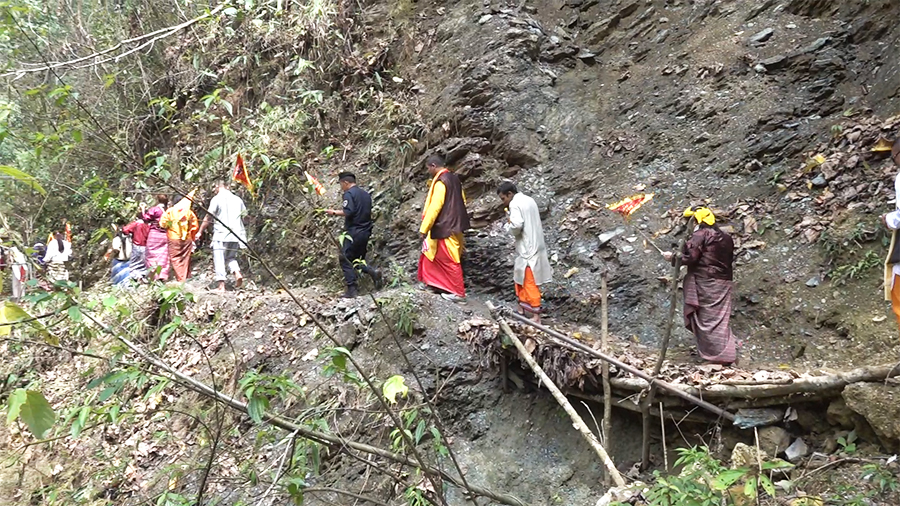
Mahakal Dham or Bukay Dham, a revered Hindu sacred site at Bukay in Samtse dedicated to Lord Shiva is a potential ecotourism destination. However, the temple is unable to capitalize on this potential due to a lack of proper footpath. The caretakers of the scared site are struggling with funding constraints, maintenance issues, and accessibility challenges.
Before the COVID-19 pandemic, the site received thousands of pilgrims, especially from India who came to offer prayers and sacrifices to Lord Shiva.
While the number of visitors has decreased compared to the previous years, pilgrims from nearby regions in India still make an annual pilgrimage to the temple.
“I have visited this sacred place many times, and this is my first visit since COVID-19. Our love for this place remains unchanged. In the past, climbing the mountains used to take us a lot of time. However, now we have a road that takes us halfway, and from there, it’s just a short hike of a few minutes. We are devoted followers of Lord Shiva, and coming here always fills us with immense joy,” said Aman Turi, a visitor from India.
“I have come here with a wish in my heart. This sacred place brings us a sense of peace and tranquillity. We firmly believe that by visiting here and making a wish, it will be granted. May the blessings of Lord Shiva be upon us all,” said Ambika Malpariya, also a visitor from India.
 The footpaths leading to the site were built with railings last year with the help of the Samtse Gewog administration have been rendered ineffective due to the swelling Bukay River and frequent landslides, making the path hazardous and difficult for visitors.
The footpaths leading to the site were built with railings last year with the help of the Samtse Gewog administration have been rendered ineffective due to the swelling Bukay River and frequent landslides, making the path hazardous and difficult for visitors.
“The footpath leading to the sacred site is challenging for visitors, particularly tourists, due to its poor condition and broken railings. Although the sacred site itself is in perfect condition, some footpaths are risky, situated on cliffs. We make regular efforts to maintain the footpaths, but landslides during the monsoon season always damage them,” said Thakur Singh Ghalley, chairperson of Bukay Dham Community Forest.
He added that the sacred site could become a popular ecotourism destination attracting visitors from both within and outside Bhutan if these issues are resolved.
“Visitors from major cities such as Delhi, Mumbai, Kolkata, and Hyderabad, as well as hillside areas like Darjeeling, Kalimpong, Sikkim and Gangtok in India, frequent our sacred site. Moreover, as word spreads among Bhutanese people, we are also receiving an increasing number of local visitors from nearly ten districts across the country who come here to offer their prayers,” added Thakur Singh Ghalley.
Local beliefs suggest that the sacred site existed for over 400 years and is among one of the oldest in Bhutan. According to the village elders, the site was discovered by a herder who witnessed a pundit, a dog, and a deer entering the cave.
Today, about 30 members from the Bukay Dham Community Forest take care of the sacred site, which also features a guest house for visitors. Located around 10 kilometres from Samtse, it takes about 20 minutes to reach the site from its base.
Passang Dorji, Samtse
Edited by Phub Gyem






